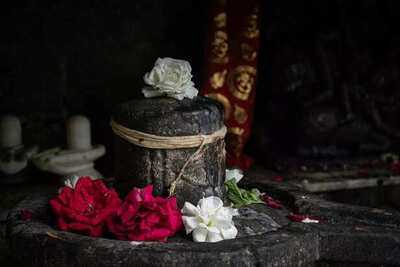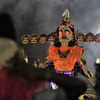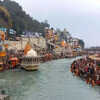
Every July, roads across North India transform into rivers of saffron. Chanting “Bol Bam!” and walking barefoot under the blazing sun, millions of Kanwariyas carry holy water from the Ganga to offer at Shiva temples — a devotional act that has grown into one of the largest annual pilgrimages in the world, with over 3 crore participants in recent years.
But behind this massive modern movement lies a lesser-known tale whispered through temple walls and local lore — that the first Kanwar Yatra might not have been led by sages or saints, but by a rakshasa.
Yes, Ravana, the fearsome king of Lanka — the villain of the Ramayana and yet a devout follower of Shiva — is said in some traditions to have once carried Ganga Jal to appease the god. In some versions, he even carried the Shiva lingam itself, walking miles in penance and pride.
There is no single scripture that confirms this myth, but its persistence across folk songs, regional temple legends, and Shaiva oral traditions offers a fascinating glimpse into how faith, power, and myth often overlap. 1. The Mythic Context: Shiva, Poison, and the Cooling Waters

The Kanwar Yatra finds its ritual roots in the cosmic event of
Samudra Manthan, or the churning of the ocean, when Lord Shiva consumed Halahala, the deadly poison that emerged. To cool his burning throat, he is said to have been offered Ganga Jal — water from the sacred river Ganga.
In later devotional tradition, this act became symbolic: bringing Ganga Jal to Shiva as a way of aiding the god who saved the cosmos. Over time, it evolved into the practice of pilgrims collecting water from sacred rivers and walking barefoot to pour it over Shiva lingams during the holy month of Shravan. 2. Ravana’s Role: Devotee or Manipulator?

According to certain regional legends and Shaiva Puranic references, Ravana was a fierce devotee of Lord Shiva. His bhakti wasn’t soft — it was intense, violent, even bloody. Stories claim he offered his ten heads in penance, one after another, at the feet of the Lord. This extreme devotion is often viewed in the lens of tapasya, the spiritual power generated through suffering.
In one version of the tale, Ravana journeyed to Mount Kailash, carrying water from the Ganga to pour over the Shivling. Some connect this act to the earliest Kanwar-type ritual, though the Purāṇas do not explicitly use the word “Kanwar.”
This story isn’t canonical in the same way the
Ramayana is, but it exists in many oral traditions, local temple lore, and regional interpretations of Ravana's complex relationship with Shiva.
3. The Purpose Behind Ravana’s Devotion

Unlike modern Kanwariyas, whose aim is
seva (service) and
shanti (inner peace), Ravana’s devotion had motive. The legends suggest he sought boons of invincibility and cosmic control through his penance. This was not surrender; it was transactional spirituality, a sacred bargain with the divine.
This contrast raises a profound philosophical question:
Is action still holy when the intention is control, not surrender?
In portraying Ravana as the first Kanwariya, the myth blurs the line between devotion and ambition, faith and ego, showing that even acts of spiritual discipline can stem from darker desires. 4. Why the Story Persists: Power, Symbolism, and Shadow The association of Ravana with the Kanwar Yatra continues to resurface in folk songs, local sthalapuranas (temple texts), and even modern religious discourse. For some, it adds depth and antiquity to the ritual — a way to connect with pre-Vedic or non-Aryan expressions of Shiva worship, where Rakshasas, tribal kings, and outcastes often played pivotal roles.
For others, it’s a cautionary tale: even a devotee as powerful as Ravana failed, because his devotion was mixed with ego and desire. His Kanwar-like act did not lead to liberation but downfall. 5. The Lingam of Ravana: The Baidyanath Dham Connection

Another thread links Ravana to the Baidyanath Jyotirlinga in present-day Jharkhand. Legend says that Ravana was granted this lingam by Shiva himself, on the condition he would carry it without placing it on the ground. When Ravana set it down (or was tricked into doing so), it became fixed to the spot — now the Baba Dham temple.
Some scholars and devotees interpret this event as part of the same Kanwar journey — carrying a sacred object with discipline and surrender, and the consequence of failure.
Whether literal or symbolic, this story is still part of the pilgrimage tradition, especially among those visiting Baidyanath during Shravan.
 Every July, roads across North India transform into rivers of saffron. Chanting “Bol Bam!” and walking barefoot under the blazing sun, millions of Kanwariyas carry holy water from the Ganga to offer at Shiva temples — a devotional act that has grown into one of the largest annual pilgrimages in the world, with over 3 crore participants in recent years.
Every July, roads across North India transform into rivers of saffron. Chanting “Bol Bam!” and walking barefoot under the blazing sun, millions of Kanwariyas carry holy water from the Ganga to offer at Shiva temples — a devotional act that has grown into one of the largest annual pilgrimages in the world, with over 3 crore participants in recent years.
 The Kanwar Yatra finds its ritual roots in the cosmic event of
Samudra Manthan, or the churning of the ocean, when Lord Shiva consumed Halahala, the deadly poison that emerged. To cool his burning throat, he is said to have been offered Ganga Jal — water from the sacred river Ganga.
The Kanwar Yatra finds its ritual roots in the cosmic event of
Samudra Manthan, or the churning of the ocean, when Lord Shiva consumed Halahala, the deadly poison that emerged. To cool his burning throat, he is said to have been offered Ganga Jal — water from the sacred river Ganga.
 According to certain regional legends and Shaiva Puranic references, Ravana was a fierce devotee of Lord Shiva. His bhakti wasn’t soft — it was intense, violent, even bloody. Stories claim he offered his ten heads in penance, one after another, at the feet of the Lord. This extreme devotion is often viewed in the lens of tapasya, the spiritual power generated through suffering.
According to certain regional legends and Shaiva Puranic references, Ravana was a fierce devotee of Lord Shiva. His bhakti wasn’t soft — it was intense, violent, even bloody. Stories claim he offered his ten heads in penance, one after another, at the feet of the Lord. This extreme devotion is often viewed in the lens of tapasya, the spiritual power generated through suffering.
 Unlike modern Kanwariyas, whose aim is
seva (service) and
shanti (inner peace), Ravana’s devotion had motive. The legends suggest he sought boons of invincibility and cosmic control through his penance. This was not surrender; it was transactional spirituality, a sacred bargain with the divine.
Unlike modern Kanwariyas, whose aim is
seva (service) and
shanti (inner peace), Ravana’s devotion had motive. The legends suggest he sought boons of invincibility and cosmic control through his penance. This was not surrender; it was transactional spirituality, a sacred bargain with the divine.
 Another thread links Ravana to the Baidyanath Jyotirlinga in present-day Jharkhand. Legend says that Ravana was granted this lingam by Shiva himself, on the condition he would carry it without placing it on the ground. When Ravana set it down (or was tricked into doing so), it became fixed to the spot — now the Baba Dham temple.
Another thread links Ravana to the Baidyanath Jyotirlinga in present-day Jharkhand. Legend says that Ravana was granted this lingam by Shiva himself, on the condition he would carry it without placing it on the ground. When Ravana set it down (or was tricked into doing so), it became fixed to the spot — now the Baba Dham temple.